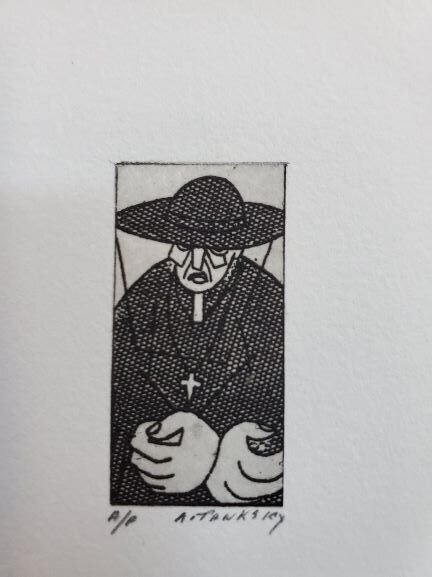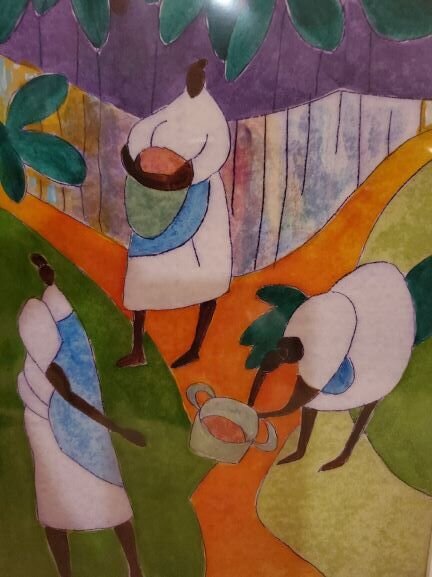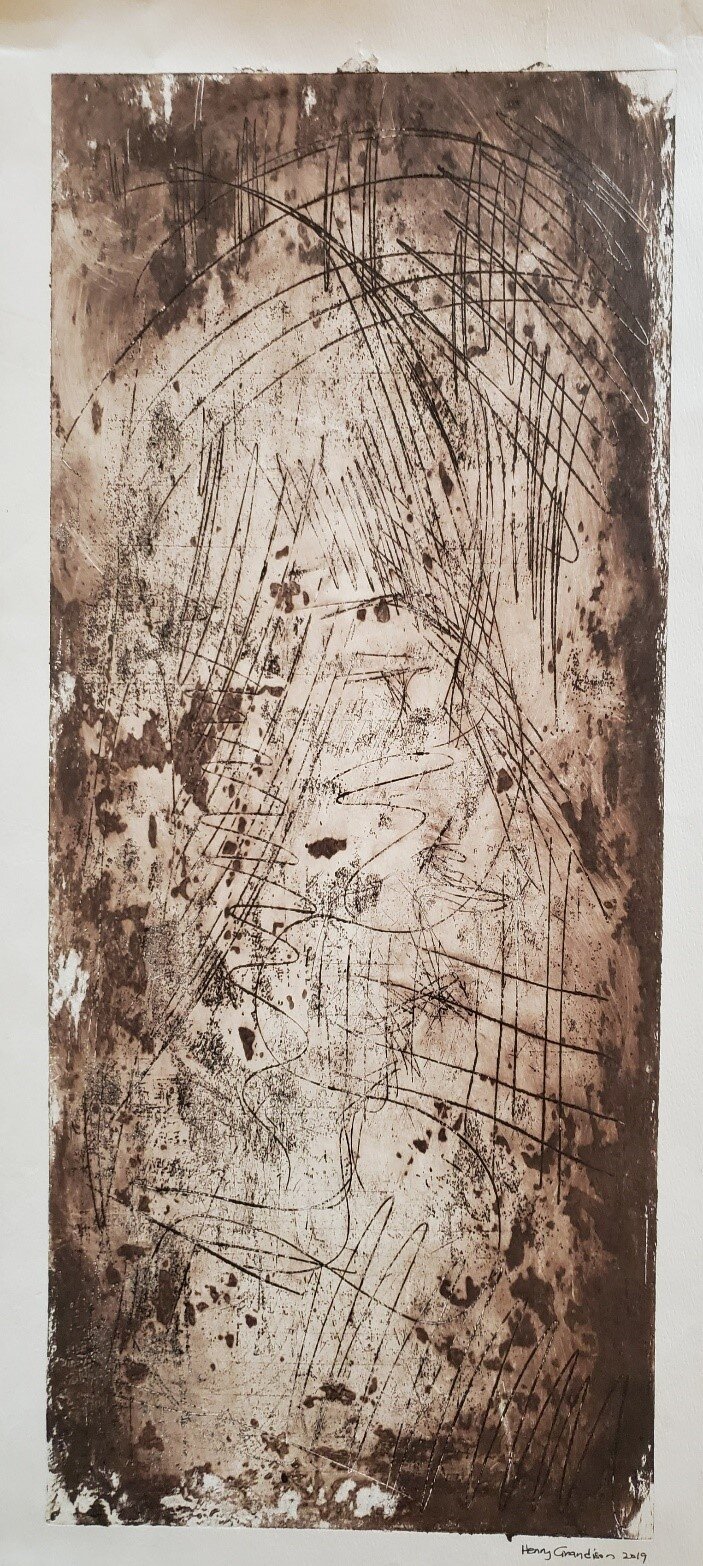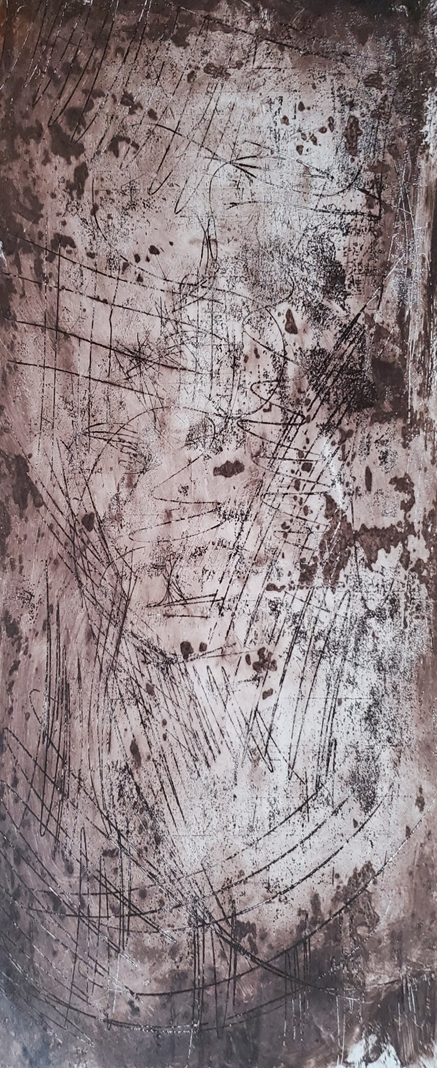Art Hedge is pleased to feature Richard Nattoo, a Jamaican fine artist, architect and musician, b. 1993. Concerned that Art school would interfere with is ideas and style, he did not attend. He is interested in the human condition. Watercolor, glass, pen and ink are his media. He has been exhibiting his work since 2012. His current art practice focuses on painting his emotions, feelings. Richard did not study philosophy. But his ideas on the Aesthetics of painting are reminiscent of the German Romantics, and non-rationalist philosophers like Schopenhauer and Maurice Merleau-Ponty.
Read MoreThe Art of Printmaking and Digital Painting: Henry Grandison at work.
“Every Act of Creation begins with the Act of destruction * ”
*Picasso made more than a thousand prints.
Ann Tanksley, Hibiscus
Henry Grandison: Printmaker and Digital Artist
This post highlights printmaking and digital painting through the eyes of Henry Grandison. Last year Art Hedge featured Henry, “In His Own Words”. He has since expanded his art making practice to include intaglio printmaking and digital painting. Once again, we are pleased to showcase Henry’s works and to introduce, collectors, new and seasoned to the art of printmaking..
The Art Hedger was a member on the board of the Center for Contemporary Printing, (CCP) in Norwalk. Anthony Kirk, a specialist in monotype, intaglio and relief printmaking, was the master printmaker at the time. Tony introduced me to the tradition of printmaking. I learned that the art of printmaking is technical, rigorous, demanding, expensive and difficult. Also, I discovered the joy of collecting artists like Ann Tanksley, Howardina Pindell, among others.
The history of European printmaking starts in the 15th Century. (See, Arthur M. Hind, A History of Engraving and Etching from the 15th Century to 1914). But printmaking is older than that. The Chinese and the Japanese have been printing on cloth and paper dating back to at least 230 AD. 700 AD. respectively.
So, what is printmaking?
Printmaking is a technique where an image is carved, etched into a medium or “matrix”, such as, wood, linoleum, stone, metal plate, etc. The surface of the medium is covered with ink; paper is placed onto the inked surface and putting pressure by hand or with a machine creates an impression or print. Each print is considered an original.
The Intaglio printmaking technique involves creating an image by cutting into the surface of a copper plate and removing metal or scratching or cutting into the surface and pulling the metal creating a ‘burr’ or raised metal, on the surface of the plate. Ink will be ‘trapped’ under the burr resulting in softer lines on the print.
Digital Painting
Digital fine art paintings are created with the aid of digital technology: software programs, stylus, tablets, scanners, and printers. Different printmaking techniques can be used to transfer the computerized image into an impression or print. Andy Warhol and David Hockney used the digital medium.
Henry Grandison’s Intaliglio Prints
Henry Grandison, Man and Nature, 2019
This was my initial attempt at intaglio printing. This print gave me a lot of insights into the overall process.
The piece is about the inextricable connection between man and nature. In many contemporary societies, it is thought that there is a dichotomy between man and nature. Man is seen as the master or transcendent of nature. I created an etching of a man with hair made of foliage. This symbolizes that man and nature are connected on both a physical and metaphysical.
I always had a fascination with printmaking. So, last year I decided to try printmaking specifically intaglio printing. I struggled at first to learn the process of creating plates and using a printing press. It was very nerve racking to make marks into the plates. The permanency of it led me to question each line I etched across the plate. When I finally finished the first plate I had intense feelings of accomplishment wash over me. I went on to make three more plates within a couple of weeks. The first few prints I made were not successful. So I made adjustments to the watercolour paper, etching inks and the press pressure until I got a good print. Then I experiment with woodblock inks instead of etching inks and superimposing some of the print designs…
Henry Grandison, Man and Survival, 2019
In this work, I wanted to explore our relationship with technology. Technology is normally created to aid in human survival and comfort. However, technology is also an instrument of death and destruction. The image of some falling onto some spears — one of mankind's earliest technology — is used to evoke the dangers of technology.
Henry Grandison, Abstract Void, #1 Henry Grandison, Abstract Void, #2
… I wanted to explore form and space. I did not want anything representational in the piece. So, I used spontaneous marks on the plates. I wanted it to be a pure reflection of what I was feeling at that moment.
Henry Grandison’s Digital Painting
…Digital painting was a revelation for me... I investigated the use of grungy textures paired with shallow and abstract space. I also played with the use of monochromatic colour schemes. I tackled themes that resonated within, such as, isolation, fear, the cosmos and identity. A few recurring subject matter in my work are cosmic nihilism and the homeless.
Henry Grandison, Invisible Man
In Grandison’s Invisible Man the homeless man is the focus of our gaze. The rest of “us” are vague, flat, blending in indifferently in the background. The work was printed on artist paper using offset printing technique.
Henry Grandison, Untitled
This Untitled work reminds me of Hank Willis Thomas’ I Am Man themes. The piece engages me. Maybe this is Henry’s own Cosmic nihilism, time ravishes, you grow old and just eventually die.
Following a rich tradition
Henry is following in the footsteps of a rich tradition of Jamaican printmakers. One example, Vernal Reuben (b. 1911) was a master printmaker, see Construction Worker, wood cut, 1976 (World Bank Art Collection). He taught printmaking at the Jamaica School of Art (Now the Enda Manley School of Visual and Performing Arts). Reuben studied with African American master printmaker Robert Blackburn (1920 – 2003); his parents were Jamaican; he printed editions for Jasper Johns and Robert Rauschenberg, among many others.
Bridging Centuries…
Henry has taken on a 15th Century art form, intaglio, with its demands and is thriving in a challenging practice environment. He is a digital native, at ease in the medium of digital art. At the same time he is cognizant of the limits of technology. His current practice is a synthesis of ancient and modern techniques; both offering him an opportunity to innovate and develop. Grandison’s works are compelling, engaging, intelligent and empathetic.
…I am still in the early stages of my printmaking journey and I will document my development.
As Henry “develops his voice,” we relish the opportunity to amplify his voice.
We would love to hear from you:
And Please visit the store:
Thank you!
Henry Lowe: Artist, Fisherman, Teacher →
Henry Lowe is a Jamaican Artist. He was born August 1960 just a few years before Jamaica gained its independence from Britain in 1962 in St. Mary, the birthplace of Master painter, Alexander Cooper, b. 1934. In addition to pursuing his passion of making art, Mr. Lowe is a deep-sea fisherman and a School Teacher. His son is also an Artist.Henry was trained at the Edna Manley School of Visual and Performance Art. And he came of age as an artist at a time that has been labeled “post-colonial”. Yet, he continues the rich Tradition of excellence established by his predecessors: Pottinger b. 1911, Huie b. 1920, Watson b. 1931, to name just a few. He is enamored with the landscape just like Frederic Edwin Church, the Hudson River painter, who visited Jamaica in 1865, after the Morant Bay Rebellion
Read MoreHenry Grandison, Untitled, work on paper
Henry Grandison--In his own words
Henry Grandison is a multi-talented Jamaican Artist. He works fluently in different media; drawing, painting, illustration but his passion is comic art. He is a graduate of the Edna Manley School of Visual and Performing Arts.
Read MoreAfrican American Art - Having a “Moment”!??? Why?
After weeks of procrastination and perhaps doubt about the value of his musings, the Art Hedger, prompted by “Art Guy’s" Charles Desmarais’, tackles the question: Is African American art having a moment? He makes it clear that the “moment” question is at least 11 years old. It’s a “moment” decade, if not centuries building, in the making, and maybe, we can all agree, a long time coming. His conclusion: The question “Why African American Art is Hot" is skin-deep. I believe it ignores the complex sociocultural, economic, and political legacy of America. It allows for the possibility that progress is fleeting (and it might be) and does not recognize the pain of dreams exploded and deferred. Art is our mirror…”
Read MoreTAFA in his Harlem Studio with Protest Rhythm, Oil on canvas, 46” x 26”
Reconnecting with TAFA-Two main works
Art Hedge and friend reconnect with TAFA and visit his art studio in East Harlem. They discuss fine art, contemporary and break bread at La Fonda Boricua. The Art Hedger then leaves for the Bushwick Art Fair.
Read More“True Reflections” Jamaica – letting go of “TuPac”, finding Empathy, Inspiration & Connections
This is the Art Hedger’s second blog. “True Reflections” Jamaica – letting go of “TuPac”, finding Empathy, Inspiration & Connections. He stops off in Montego Bay before heading to a conference, Destination Experience in Kingston, and travels east to Ocho Rios where he visits an art gallery, “True Reflections”, and meets the artist, Granville Graham and a young boy who has formed an intense attachment to the Tupac, a fine work that the Art Hedger buys from the artist. The artist and boy must deal with letting go of the image. The Art Hedger experiences an empathetic moment. He travels further east to Annotto Bay where he meets masterful artists, father and son, Henry Lowe and Henry Granderson. He connects with the artists and is inspired.
Read MoreThe Art Hedger’s first blog
The Collector’s muze is the Art Blog for Art Hedge. The first blog introduces the Art Hedge Collection: art works by Dwight Beard, Dr. Cora Marshall, Ann Tanksley, Al Loving..
Read More












